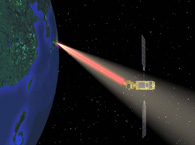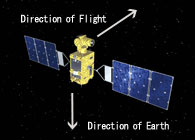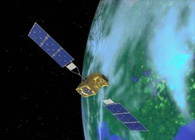| Q. How did you find the collaboration with ESA? It went really well. The Kirari and ARTEMIS projects were started around the same time: Kirari in 1993, and ARTEMIS a few years prior. As well as myself, the core members of both teams stayed the same throughout the whole period, too. Once both teams decided on the performance profiles of the laser communications equipment, we worked on development separately. This is similar to the way things work in industry: for example, there are common standards for cellular phones, but companies compete to develop products. After mutual standards had been set, we competed to develop high-performance laser equipment. Because there was a lot of cutting-edge technology involved, we kept our own technological information secret during development. However, both teams successfully cleared the objectives and were able to build devices that everyone was happy with. With this successful result, I think we have proven that international collaborative experiments are achievable even at this advanced level. I am also convinced that the relationship between Japan and Europe has been further reinforced. Q. Tell us about the successful optical communication experiment with the NICT optical ground station in March 2006.
Kirari? optical communications equipment is usually facing away from Earth, and we had to rotate the whole satellite 180 degrees, so the equipment would face the direction of the ground station. It was the first time we had turned the satellite around to communicate with the ground. The experiment was basically optional, so there was surely some worry that the satellite might not return to its original position later. But we had done so much advance inspection that we were quite confident of the safety of the satellite. Having said that, nobody knows, after all, what could happen in space, so the truth was that I was a little nervous. For this experiment, we had to aim Kirari? laser beam within an area of about 5 meters. In addition, the most difficult part of communication with a ground station is the unavoidable influence of the atmosphere. The refractive index of the transmission path of a laser beam is affected by temperature or wind, or can be blocked by a cloud. As a result, the energy of the laser beam is diminished, which instantly causes a significant change in circumstances. It was quite complex to track and maintain communication by laser beam with such variable optical reception levels. Four experiments were carried out in March, and all were successful except for one, which was cancelled due to bad weather and thick clouds. This successful communication between a low Earth orbit satellite and an optical ground station was the first in history. These two different first-time-ever experiments have given us great confidence. Kirari is indeed an achievement. Q. How are our daily lives going to be affected by optical satellite communications? The basic method for conventional data communications between an Earth observation satellite and a geostationary satellite is radio waves. But laser beams can increase the volume of data we can send by many tens of times. Another benefit is that the antennas can be much smaller ?about 1/10th to 1/20th the size of conventional ones ?since laser beams have shorter wavelengths than radio waves. Kirari and ARTEMIS use antennas 25 cm in diameter, while the size of an antenna of the Earth observing satellite Daichi (ALOS) is 1.3 m and that of the Data Relay Test Satellite Kodama (DRTS), is 3 m. Moreover, laser communications consume smaller amounts of electricity, so there can be great gains in electronic efficiency, as, for example, solar panels and batteries will be smaller. Kirari is just the beginning for optical satellite communications, so there is still a lot of room for improvement ?for higher transmission speeds and larger data volumes. But there is the promise that optical satellite communications will be the foundation of future space activity. |
| 1 |


